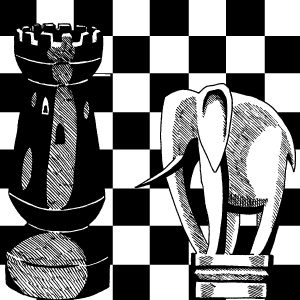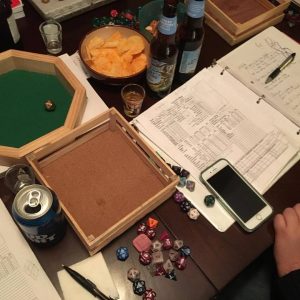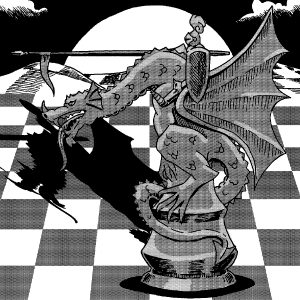
Two armies face off across open grassland. The sun is high and the spearheads and polished helms of both sides glitter and glare brilliantly in the intense sunlight. The air taught with anticipation, every sweating man is on edge and a combination of fear and anxiousness causes the soldiers in their formations to sway out of sync slightly. Regardless the colorful and varied war banners of both sides writhe in the slight breeze.
The shouts of the sergeants beat the nervous air like a drum skin thrumming into the soldiers’ ears. Feet begin to march in step thumping along the ground, stomping grasses, sending a continuing pulse through the earth. The front ranks of skirmishers move towards a similar oncoming line under the fire of slingers and the arrows of archers. As both lines reach a certain distance from one another, they charge screaming their battle cry at each other tearing sod until they crash together. Suddenly a mind-shattering roar blasts the air drowning out the battle cries and death moans of hundreds of men. Bloodied faces turn to the sky in terror.
The few sergeants still able to keep themselves together on one side call for archers to take formation and the ballistae to ready. Soldiers in the rear ranks raise their scuta in a semi-Tortuga formation for the archers to take shelter between. Then the shadows of the roaring beasts become visible as they make their attack descending from their typical flight pattern parallel to the sun. Dragons and on their backs their riders wielding the beasts themselves as both war-mount and weapon. Immediately they strafe the front lines of the enemy unleashing gouts of flesh and steel melting flames.
Fusillades of arrows and bolts fly but most are flung away by the massive beats of the monsters’ wings. A few lucky shots bring one beast down and another loses its rider as he flew too far into the center of the enemy force risking snatching up a general. However, in the end, the side without the dragons eventually breaks formation and a majority of its men flees for their lives. The veteran core surrenders, as they stood too long to run away. The enemy’s counter-measures had made the victory expensive but the victor’s massive investment in a handful of dragonriders ultimately won them the battle and perhaps the war.
What fantasy battlefield is complete without a dragon or two? In particular, what fantasy army would not try to take advantage of such a powerful and fearsome animal in the form of trained beast or better yet, as the mount of a rider? A dragonrider is the ultimate weapon when talking medieval fantasy battles. It is the equivalent of an air force and its fiery breath the equal of hellfire missiles against armored men, horses, and wooden engines of war. These beasts of legend could be the ultimate advantage on the field against any enemy that lacks aerial capability even rendering the defensive value of fortresses and even castles ineffective.
Dragons on the Field
The dragon is a creature that is very common to fantasy RPGs and which has deep mythological roots but for the purposes of war, we need only know of its offensive potential. The intelligence and trainability of dragons may vary radically depending on the world or setting of your game. In fact, in certain settings dragons may be the powers behind the fielded armies in the first place. However, we are concerned with the general definition of the dragon around which we will build the tactics, logistics, and counter-strategies required for operation on the battlefield. This definition will also allow the dragon to be ridden by a single rider or a crew either as a beast or as companion.
Dragons are physically powerful reptile-like creatures with claws and teeth and the ability to fly. They possess a breath weapon of some kind but it is typically fire. They can range in size from horse-size to the size of elephants or even whales. This definition answers the standard fantasy trope and will assume that the dragon can be used as a mount as mentioned previously. The only things left to answer are the famous penchant of dragons for hoarding treasure and their level of intelligence.
The dragon hoarding behavior may be retained and even manipulated by its crew or rider by rewarding or awarding medals for battlefield performance (this behavior more directly addressed and thoroughly discussed in Tabletop Meditations #6: Dragons) as positive reinforcement. If they are actual recruits instead of just battle beasts then pay in gold coin or gems is also a motivator as well as providing satisfaction for an ingrained behavior of the dragon. However, this behavior can get out of control such as when spotting a gleaming object on the ground or dropping to the ground in mid-flight to snatch up a shiny but useless piece of trash. A knowledgeable enemy could use this quirk to bait the dragon into a trap while en route to the field. The dragon regardless of how intelligent it is might remain a slave to its animal instincts.
Conceivably training a dragon is similar to that of a mundane animal though using somewhat different methods. If they are close in intelligence to humans then training requires other tricks and modes of training to coerce or lull them into servitude. However, if more than or just as intelligent as humans then dragons could head armies as elite troops, officers, or perhaps even its overlord. It is safe to say that if a dragon is a mount with a rider or aerial platform with a crew then dragons, at least of that type, are of one of the first two orders of intelligence. This is not to say that there is not a variety of different dragon species in the given setting however.
Advantages of an Air Force
Though the advantages of a battle dragon are numerous, the primary one and the one that is most obvious is the use of dragons as a sort of air force, which could easily dominate a medieval battlefield even over other non-draconic flying creatures. They have the supreme advantages of pure intimidation factor, the choice of taking a single action that could turn the tide of battle, and the option of making targeted attacks from the air.
The pure intimidation factor of these types of creatures would definitely have a negative effect on the morale of the enemy. This is especially true if the other side lacks a dragon-force of any type. This may lead to some weaker enemies and just competent enough generals into surrendering immediately. However, the rider may need their dragon to encourage the enemy retreat by roaring, blowing flame into the air, or sending a windblast via a wing beat towards the enemy’s front lines.
Wing Beats from such a large and powerful animal would have the potential to blow over light wagons (especially covered wagons, they would catch the wind), knock back a few troops, or raise a blast of obscuring dust. Such a tactic might also halt the advance of a small unit either to buy time or to set them up for an offensive action.
Of course, this action will probably not deal any damage but is a delay tactic coupled with the intimidation factor of the dragon. However, the main reason to recruit dragons to your side in the first place is to win and dragons are capable of making battle-turning actions. A battle-turning/winning action is a single action that can alter the tide of battle. These types of actions can tilt the favor to the dragonriders’ side. In the very least, these types of actions can devastate the enemy opening a chance for the opposition to take up a winning position or enact a victorious strategy. Of course, all of these winning strategies involve strafing the slower grounded targets.
Dragons can strafe using their breath weapon or their natural weapons such as claws, tail, or bite. If the dragon has horns then those as well. A flyby using those natural weapons can devastate individual soldiers, wagons, smaller war-engines, and even small squads of warriors while allowing the dragon to get out of harm’s way simultaneously. Using the breath weapon in a strafing attack is always effective and especially deadly to naval vessels due to the rigging, sails, and tarring.
War dragons can also use targeted attacks in order to contribute or enact specific strategies. Targeted attacks are those strategically aimed at specific goals. This includes attacking such high value targets as supply wagons, war machines, and disrupting individual units especially command units or even commanders. This type of attack often has the dragon fly in and snatch up an individual or group of individuals then fly straight up and drop them.
Now, if the point of the attack is to take out a specific individual or group then all the beast has to do is let them go. However, if it is to disrupt a unit then using those in the dragon’s grip as a drop-projectile is the main strategy by swooping around and then diving in at full speed just before releasing the unfortunates at top speed. Another targeted attack is to go after wagons and war engines which can be as simple as overturning them damaging them and causing the enemy crew to occupy themselves righting/repairing the engines or wagons as well as picking up the spillage. The dragon’s natural powers are the ‘A’ strategies but the tactical ability of the rider and dragon mount can always be enhanced.
Riders and Weapons
A smart commander would of course want to try to enhance the offensive capabilities of their war dragons and their riders, conventionally achieved by arming and armoring them. However, which weapons are the most effective from the back of a dragon and what are best suited to the dragon itself? The most obvious possibilities are the archery skills of the rider, lances and spears, and flechettes or weighted darts. The previous are also probably the best options unless alchemical grenades are available.
Archery is no good if the dragon has strong instincts to snatch or snap at arrows flying around their faces or within reach (used to snatch birds from the air as food on the go). However, this instinct may help with defense against incoming arrows and other small projectiles. Another question to answer is about stability. Is the dragon a stable enough platform for average skilled archers to fire from, if not, then archery is not a good option. This is true even if it is no problem for elite archers, those are expensive and take time to train and/or gain experience.
In any case, the dragon can still be a bombardier. The rider can drop weapons and/or explosives on the enemy from above, hopefully from heights too high for them to retaliate with arrows. Also, do not forget that baskets of rocks, iron balls, or sling bullets can be used in a similar fashion. When it comes to forged weaponry, it is probably best to rely on the dragon’s natural assets for direct attack and then use the rider’s ability to drop things as a precision attack unless the situation calls for a bombing run.
Dragons and Weapons
Dragon Barding (armor) and blade spurs (like a fighting-cock); tail blades/weights are all possibilities to arm the creature. However, the dragon’s natural weapons are probably more effective than any manufactured device of the medieval level. Barding may increase the creature’s defenses but may be more of a burden as it stands to slow the dragon down and interfere with its flight ability. A chest plate to protect the creature from heart shots is conceivable but its slight defense value might still be outweighed by the weight burden or any restrictions to dexterity.
Where lances and similar weapons would be most useful is in Dragon-to-Dragon duels. However, lances and spears may not be very practical in that the forces involved may overwhelm the lancer. A large dragon hauling a crew on its back may employ long spears to fend off attacking dragons as well as possibly using crossbows all in defense of their dragon instead of for use on grounded enemy. However, in these fights the dragon’s own fighting ability and its natural weapons would play the most vital part in the confrontation.
Logistics & Dragons
With beasts as mighty and as large as dragons, the logistics are a nightmare. Dragons as war beasts require control, they demand vast resources, and of course, they need to eat. The most pressing concern is a constant food supply. Foraging or farm pillage may not satisfy this. Overstretched supply lines and scorched earth can make it an impossibility.
Assuming that like a Red-Tailed Hawk a dragon must eat 1/20th of its own body weight in food per day with maybe a day or two of fasting each week, a single 1,000lb dragon would require 50lbs of food per day; 250lbs per seven-day minimum. Note that this amount is not just to stave off starvation but also to prevent succumbing to their predatory instincts. They require enough food to prevent them from preying on the beasts of burden on whose backs the army supply train moves or cavalry mounts thus reducing the army’s military might. They might even snatch up their own troops as a meal if they are starving. This is where control over the mighty winged beasts comes in.
By training the beast as in training a war mount or soldier, the latter if the creature is intelligent, can achieve the control an army can make use of although the dragons’ instincts might still be an issue. However, training can make them a bit more predictable and safety assured as long as personnel practice respect for the creatures. In certain cases, mystical bonding might be an avenue of control. Nevertheless, this narrow avenue is reserved for specific individuals like the bonding of a hatchling bird with the first creature it sees upon hatching. This would limit this avenue by setting and to specific individuals who could have any motive in serving.
Commanders would probably prefer this type of control on the battlefield but it depends highly on the rider. The last option is drugs if possible, most settings set up dragons to be immune to most drugs or toxins though. This does not discount a very special type of narcotic that dragons may be vulnerable to at least to render them passive enough for training. The type or species of the dragon may limit this.
The flight speed of dragons is an awesome advantage but also contributes to the logistical nightmare that they pose. Riders need to be careful as to not out run their main forces and careful not to stretch the supply lines too thin too quickly. However, it is a strategic advantage to use dragonriders as an advance scouting/assault party. Of course, dragon combat-units require some sort of lodging at rest in fact any encampment especially in inclement weather would require some sort of cover for the dragons. Dragon units when following an army would have to have some space between them and the main force in order to keep an element of surprise and to allow far ranging forage. The range of the dragonrider units in an army would have to have constant reliable communication lines and would have to vary their distance and speed based on immediate needs.
Sheer cost is the last concern when dealing with dragonriders when not only to acquire, train, and maybe drug them but also to equip and feed them along with the infrastructure needed. A good commander might also want to invest in a good Draco-veterinarian and several dragon-grooms as waste management would be an issue though alchemists might make use of the draconic excretions.
The Weak Spot
For all of their strengths dragons do have a few exploitable weaknesses on the battlefield. Their obvious weaknesses, which are few, rest with their willfulness and greedy nature, their vulnerability to projectiles as flying creatures, but their primary weakness lay with their riders. The ability to take out singular riders could be enough to neutralize a dragon-unit. This is especially true if bonded with their rider and/or of an animalistic nature. The rider or captain of the crew will always have a target on their back for enemy sharpshooters.
Infiltrators could exploit the dragon units’ willfulness particularly in mating season if a female in heat could be wrangled and flown into the middle of a battle formation on the move. Setting up an obvious food source in places like box canyons and similar obvious ambush sites could also have the effect of forcing the rider and their dragon to have a struggle of wills. Likewise, their greed leaves them open to baiting with shiny and/or valuable objects. Rumors of treasure if they are intelligent may also be an effective exploit of both their greed and natural steadfastness.
Although dragons may be vulnerable to projectiles in flight, they still have some natural defenses. If they have the bird-snatch instinct, they will swat at all projectiles coming towards them. In addition, their wings can interfere due to sheer size causing air turbulence deflecting most arrows. The threat level of projectile weapons is reliant on the speed and height in the air of the dragon. This is especially true if a combatant is targeting the rider instead of the dragon.
This lack of any single great weakness leads many a mediocre commander to rest their entire war strategy on their dragons. For the most part these commanders are justified in doing so especially if they have a few dragon-born victories under their belts. However, this means that if the opposition can find a way to disable or otherwise neutralize the enemy dragons they can win the day on the field.
Countering the Dragon
There are countermeasures a clever opposition commander might take to defend or disable enemy dragonriders. The most practical would be units bearing long spears, lances, or arranged in phalanxes bristling with sarissas. They could take the Tortuga formation and use their spears to present spines to an attacking dragon. Of course, this only counters a dragon’s strafe with claws, horns, teeth, and tail. Archer regiments are another countermeasure letting vast volleys of arrows fly when a dragon comes into range mostly hoping to hit the rider/crew. Among them may be sharpshooters that aim for the rider or a vital point on the dragon like eyes or nostrils. War engines such as Ballistae, Scorpions, and/or Mangonels are essentially anti-aircraft artillery though ammunition might need modification.
Just as well, catapults can launch the dragon’s favorite food either to divert them or to poison them if possible. It is possible to stuff a large animal carcass with gunpowder as well hoping the dragon will explode when it swallows. In a similar vein, the use of poisoned bait and fouling or poisoning water holes in the path of the traveling dragon units could also work at least to delay them.
Note that if dragons are immune to the poison then this tactic is still useful as the riders may still fall victim. In the case of fortresses, outposts, and castles, roofs tiled with metal sheets and/or studded with spikes and nails as well as chain curtains/canopies with barbs and hooks could keep dragons from settling on top and blasting the inhabitants through windows and from the tops of walls and towers. Similarly, sharp iron spikes jutting from the tops and edges of walls and fortifications could do the same.
Value to the Game Master
In game terms, dragonriders on the battlefield are of great value to the Game-Master. They can pose an immediate danger and superior threat to any battle plans the Player Characters (PCs) may have in action. Dragonriders also act as a spectacular Set Piece. Moreover, they can become a new and sudden goal for the PCs to shoot for. As a set piece, a dragon attack can put some punctuation in the course of a battle as well turning the focus.
Maybe the PCs have to take out a dragon or two before the big battle if they are on the side without dragonriders or help in the countermeasures to combat them. If the PCs allies have dragonriders then perhaps the dragons require protection from enemy hit squads and countermeasures such as going behind lines to eliminate a war engine capable of downing their beasts or eliminating enemy saboteurs.
The Final Word
Of course, allied dragon riders will be an elite and highly valued force on the battlefield and in sieges and assaults against fortified positions and enemy fortresses. Dragon riders on the opposing side are a terror and it will be the responsibility of the commanders to have the proper countermeasures in place and hope for the greatest of luck on the bloody fields of war against the enemy’s dragon fire. Dragons on the battlefield are a combined Set Piece, ultimate threat/weapon, and the root of any number of potential plot points. The PCs can protect, combat, or master them and Game Masters can up the ante of any fantasy battle between the Player Characters, their allies, and their enemies. In any fantasy world where dragons exist, why wouldn’t they participate?
[do_widget id=”cool_tag_cloud-4″ title=false]

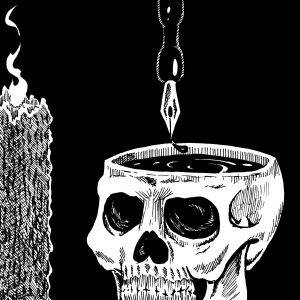 the structure of a typical fantasy RPG adventure. However, those familiar with my past articles can skip the “RPG Structure Primer” section.
the structure of a typical fantasy RPG adventure. However, those familiar with my past articles can skip the “RPG Structure Primer” section.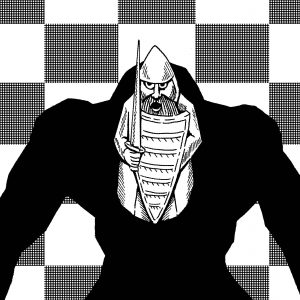
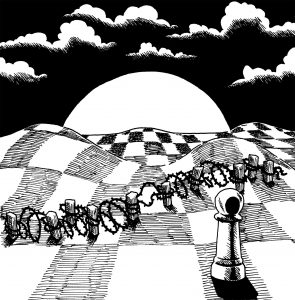 battlefield, the personal devastation realized when surveying the field of victory, roleplaying War. War can enhance a roleplaying game not just because of its opportunities for fantasy violence and power fantasies but because of its depth of emotion and intellectual involvement as well as the physical trials that characters must suffer. However, in the theater of the mind that is a roleplaying game, war becomes a mental landscape and its phases and components feature in that plane.
battlefield, the personal devastation realized when surveying the field of victory, roleplaying War. War can enhance a roleplaying game not just because of its opportunities for fantasy violence and power fantasies but because of its depth of emotion and intellectual involvement as well as the physical trials that characters must suffer. However, in the theater of the mind that is a roleplaying game, war becomes a mental landscape and its phases and components feature in that plane.